Subacromial impingement syndrome is defined by a contact between the rotator cuff and the acromion during the elevation of the arm.
Subacromial space:
Subacromial space is limited at the bottom by the rotator cuff’s tendons (in particular the supraspinatus tendon) and at the top by the acromion and the acromioclavicular joint (bone ceiling) as well as the coracoacromial ligament (fibrous ceiling ). As often in the human body a soft structure (the tendon) is separated from a hard structure ( bone) by a serous bursa, true tissue’s interposition that prevents inflammation and wear during movement.
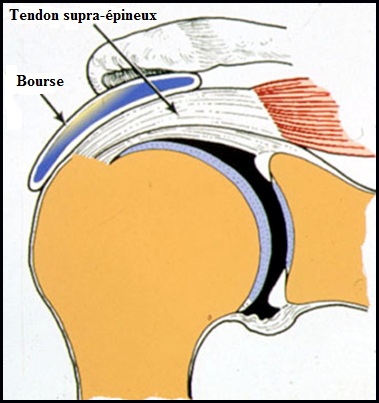
2 anomalies can occur in the sub-acromial space:
Subacromial impingement:
Frequent shoulder dysfunctions (especially rotator cuff), lead to contact between the bursa and the rotateur cuff at the bottom and the acromion at the top during the elevation or abduction of the arm.
We speak of sub-acromial conflict primary or secondary
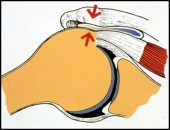
Subacromial bursitis:
The Inflammation of the subacromial bursa is responsible for hyperalgic shoulders with continuous pains or at the slightest movement.
The causes can be numerous like intensive solicitation of the shoulder by a sport, a hobby, a job; but also in relation to an inflammatory disease or a tendinous calcification of the rotator cuff.
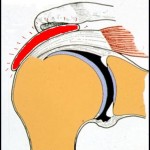
The presence of inflammation in the subacromial space does not provide good informations concerning the quality and quantity (injured or not) of the rotator cuff.
First treatment is to refocus the humeral head meaning a decoaptation of the humeral head ideally performed and taught by a physiotherapist.
There are actually 2 types of subacromial impingement, which can be isolated or associated:
The ‘primary’ subacromial impingement (mechanical)
In the event of an aggressive bone ceiling, that is to say a crooked acromion, a rubbing or crushing of the bursa or tendons may appear between the tip of the acromion and the humeral head below. Conversely, tendinous calcification can also cause such a conflict by increasing the thickness of the tendon of the cuff.
The primary conflict, however, is rarely only linked to an aggressive acromion, there is a factor favoring (overwork or contusion of the shoulder).
Primary conflict is a contributing factor to tendon’s inflammation or bursitis, then tendon’s wear of the cuff.
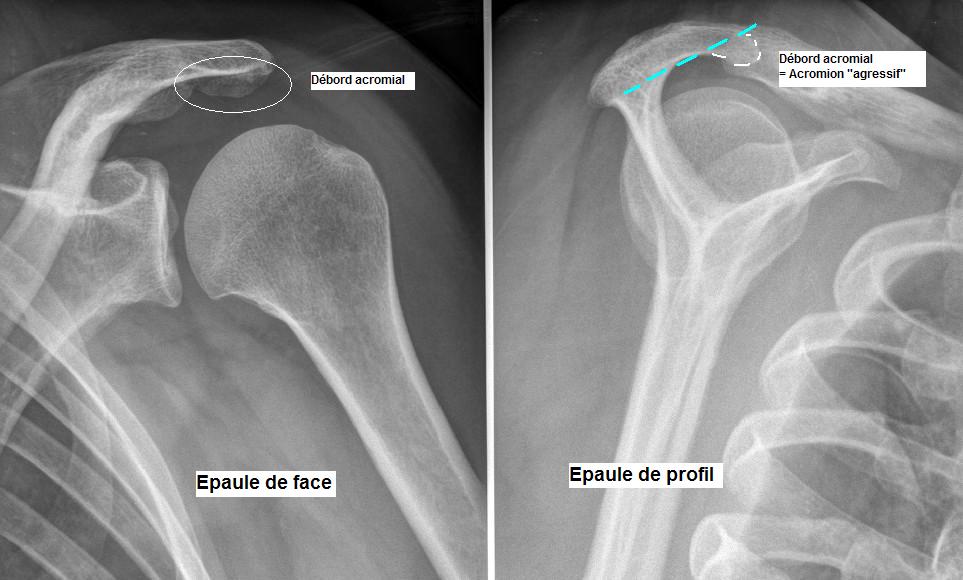
Bigliani’s classification
ThIS classification separates the acromion’s shapes according to their aggressive nature:
- Type 1 : Flat (not aggressive)
- Type 2 : curve (moderately aggressive)
- Type 3 : crooked (very aggressive)
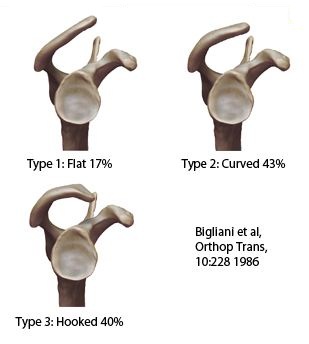
Subacromial ‘secondary’ impingement (acquired):
Quantitative failure of the tendon of the cuff (rupture) or qualitative (tendinopathies teared or not) causes the disappearance of lowering of the humeral head then inevitably leading to the impingement with the lower face of the acromion as well as the coracoacromial ligament.
Secondary impingement can’t be isolated, it is a consequence of a dysfunction of the shoulder but not the cause.
Secondary conflict is an aggravating factor for tendonitis or tendon’s lesion (partial or complete) of the cuff, realizing a kind of inflammatory and lesionic vicious circle.
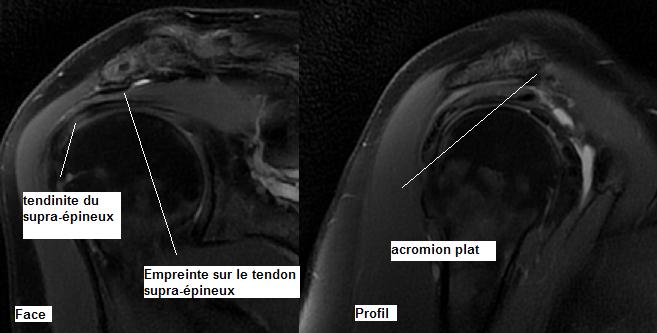
The subacromial impingement is in fact often 'sub-acromioclavicular' because the same reasoning is extended to the acromioclavicular joint when it has inflammation or osteoarthritis causing parrot's beaks below
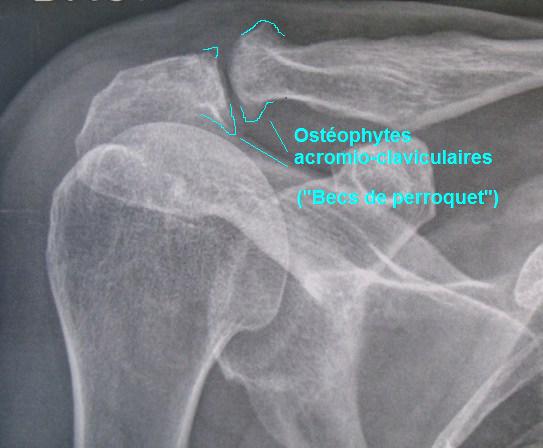
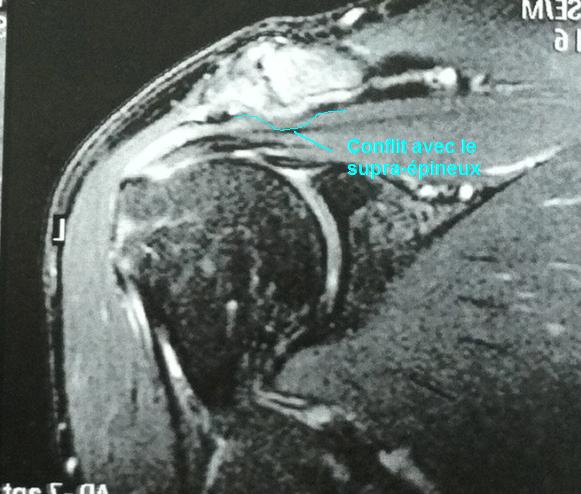
The subacromial bursa can ignite and cause pain in several circumstances (isolated or associated most often), it is called subacromial "bursitis".
The causes are multiple
- a bruise, a shock on the shoulder
- repetitive repetitive movements whether they are sports, professional or leisure (DIY, gardening, work etc …) especially when they are made to see height above the shoulder.
- tendon inflammatory disease (see broken and unruptured tendinopathies of the cuff)
- sub-acromial conflict (primary or secondary)
- resorption of tendinous calcification (microcrystalline bursitis).
Very difficult exam
Symptom
Neer test
Appearance of antero-external pain of the shoulder when raising the arm in anterior elevation
Yocum test
Appearance of antero-external pain of the shoulder when the hand is placed on the other shoulder
Test de Hauwkins
apparition de douleurs antéro-externes de l’épaule lorsqu’on exerce une rotation interne de l’épaule (abaissement de l’avant bras) lorsque le bras est à 90° d’élévation antérieure et coude plié à 90° en avant
Medical treatment of an acrominal conflict
The main and first action is to identify if possible the cause of shoulder’s overwork :
– DIY activity, gardening, renovation etc … at the level of the shoulder plan or above
-Sport intensive and repetitive or otherwise unusual
-trauma, shock or fall on the shoulder
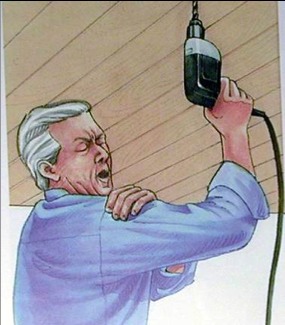
If identified = stop it !!!! and avoid any solicitation in the plane of the shoulder or above
In addition to stopping harmful activities, medical treatment of the conflict includes:
oral anti-inflammatories (or even infiltration)
but especially reeducation or self-reeducation
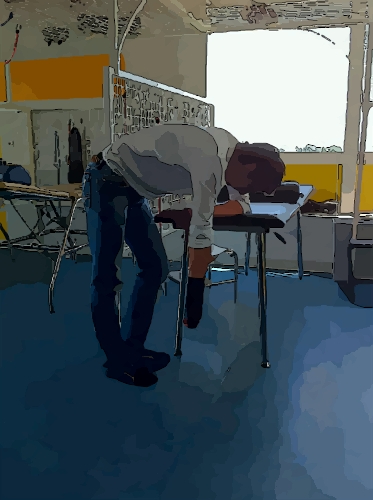
main objective = to promote the opening of the sub-acromial space by decoaptation of the humeral head (and reinforcement of the humerus humerus muscles, but this is highly debatable).
If, however, the conflict persists, surgical treatment must be discussed, especially acromioplasty in case of aggressive acromion.
acromioplasty
The principle of acromioplasty is to smooth the anterior and the outer part of the acromion in order to lift an anatomical factor of conflict with the tendons of the cap during the raising of the arm.
More the acromion is agressive more bone quantity has to be removed, so acromioplasty is important
The procedure is now performed under arthroscopy (subacromial endoscopy) using a motorized rotary bur (see video below)
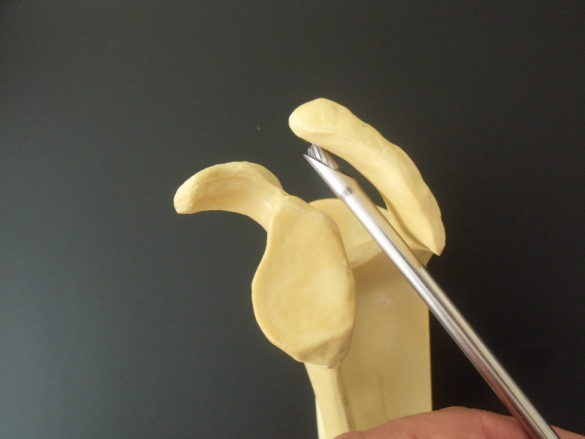
Modalities:
– Ambulatory surgery if the patient is eligible
– Relatively simple suites, transient rest of the arm in a sling without strict immobilization
– Immediate activo-passive rehabilitation (physiotherapy)
– No driving minimum 2 or even 3 weeks (possible after agreement of the physio)
– Immediate daily life activities if performed elbow to the body ++
– Physical activities and sports at 3 months if simple suites.
